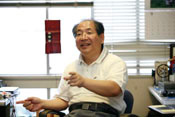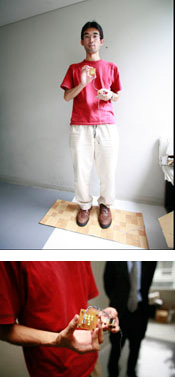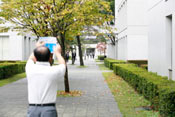Yoshiyasu Takefuji, Professor, Faculty of Environment and Information Studies
Public Transportation in evolution---New ideas for more comfortable and convenient train rides



Taking on the challenge for new public transportation services with an academic-industrial alliance, with unique ideas that break down stereotyped thinking
About three years ago, when Prof. Takefuji, who specializes in network security and neural network (information processing mechanism modeled on human brain structure) met with the president of JR East at a meeting, the two found themselves as kindred spirits as soon as they met. Prof. Takefuji revealed his research ideas related to railway services, such as the "electricity generating floor" and "transverse wave speaker", and an academic-industrial alliance was decided on at the spot. In cooperation with JR East Consultants Company, many projects are under way towards a railway service that is universally user-friendly.
"Electricity generating floor" enables passengers to generate electrical power at stations
At stations in the center of town, many people come and go. Can't this enoumous amount of transfer energy be used to generate electricity? Research of the "electricity generating floor" started from such a unique idea, and is based on the research by Kohei Hayamizu (first-year at the the Graduate School of Media and Governance), Prof. Takefuji's student, to generate electrical power with sound wave and vibration. Kohei was only an elementary student when a science class led him to come up with the idea of using sound to generate electrical power, and started to study this seriously when he was in second-year at university.
The key technology of the "electricity generating floor", which generates electricity using vibration when someone steps on the floor, is piezoelectric element. The device, which charges electricity when pressure is applied and modifies when energized, has been used in piezoelectric speakers, but never to generate electricity. Therefore, a device with a higher power generating effeciency was co-developed with Kyocera specifically for this project. In October 2006, an experiment started at the Marunouchi North Gate of JR Tokyo station to test electricity generating power and durability. In the future, the plan is to supply electrical power for escalators and lights with the "electricity generating floor", aiming for environmentally-friendly railways and stations.
"Transverse wave speaker" can give clear sounds in noisy places
Sound waves and electromagnetic waves can be divided into two types, the longitudinal wave and transverse wave, depending on direction of the wave and its vibration direction. It has been widely understood that sound waves we normally hear are longitudinal waves, that come to our ear by vibration of air. However, electromagnetic waves that are transverse waves can also be recognized as "sound"----- Prof. Takefuji found out about "transverse wave speakers" through inventor Takeshi Teragaki in 2004. Moreover, transverse wave sounds had outstanding features such as "can be heard well in noisy places", "can be heard clearly even from far away", and "can be heard by people without eardrums". Soon, Prof. Takefuji started his own research on transverse wave speakers. Today, he is trying to develop a speaker that can be heard clearly to all passengers on noisy trains and in stations.
Highly accurate GPS system can be the only way to provide information to local unmanned stations
Surprisingly, in the past, there was no way to precisely keep track of the location of trains between stations, because people understood that using low-intesity waves of GPS for location measurement is not possible in and near trains. However, Prof. Takefuji proved in an experiment on the JR Chuo Honsen that by adding up radio waves that have cyclic patterns, GPS works inside trains. Since February 2006, an experimental operation of travel information service using PVT*, a highly accurate GPS system developed by the U.S. military, is underway at JR Hachiko line, which has many unmanned stations. By adopting this system, operational information and announcement of train arrival can be provided phonetically or visually, and can also be useful in times such as when trains are not on schedule.
*PVT (Position, Velocity, Time)
Normal GPS only has location information, whereas PVT provides information of location, speed and standard time.
Faculty's Profile
Prof.Yoshiyasu Takefuji, Faculty of Environment and Information Studies
Prof. Takefuji finished the Graduate School of Science and Technology in 1983 with a Ph.D. in electrical Engineering. He served as visiting assistant professor at the Computer Science and Engineering department of the University of South Florida, tenured associate professor at the electrical engineering department of the Case Western Reserve University before becoming professor at Keio University. He has written several books for the public, such as "Let's look into the future world of cellular phones" (Iwanami Shoten), and "Story about security that you must know for yourself" (Nikkei BP). He is also known as the first one in the world to come up with the idea of camera-equipped cellular phones using satellite technology.
*Position titles, etc., are those at the time of publishing.
